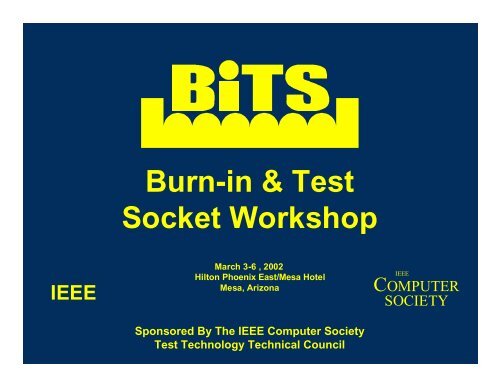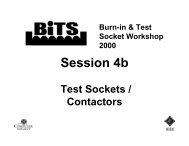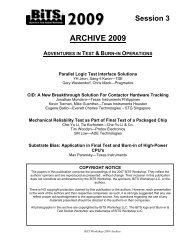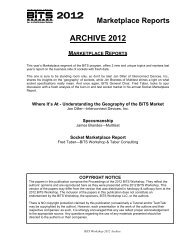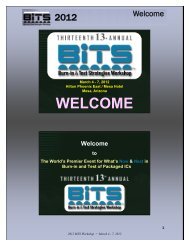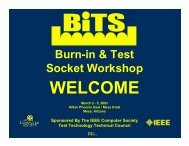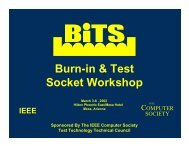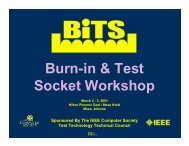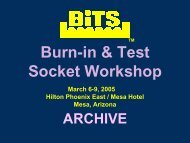Burn-in & Test Socket Workshop - BiTS Workshop
Burn-in & Test Socket Workshop - BiTS Workshop
Burn-in & Test Socket Workshop - BiTS Workshop
You also want an ePaper? Increase the reach of your titles
YUMPU automatically turns print PDFs into web optimized ePapers that Google loves.
<strong>Burn</strong>-<strong>in</strong> & <strong>Test</strong><br />
<strong>Socket</strong> <strong>Workshop</strong><br />
IEEE<br />
March 3-6 , 2002<br />
Hilton Phoenix East/Mesa Hotel<br />
Mesa, Arizona<br />
IEEE<br />
COMPUTER<br />
SOCIETY<br />
Sponsored By The IEEE Computer Society<br />
<strong>Test</strong> Technology Technical Council
COPYRIGHT NOTICE<br />
• The papers <strong>in</strong> this publication comprise the proceed<strong>in</strong>gs of the 2002<br />
<strong>BiTS</strong> <strong>Workshop</strong>. They reflect the authors’ op<strong>in</strong>ions and are reproduced as<br />
presented , without change. Their <strong>in</strong>clusion <strong>in</strong> this publication does not<br />
constitute an endorsement by the <strong>BiTS</strong> <strong>Workshop</strong>, the sponsors, or the<br />
Institute of Electrical and Electronic Eng<strong>in</strong>eers, Inc.<br />
· There is NO copyright protection claimed by this publication. However,<br />
each presentation is the work of the authors and their respective<br />
companies: as such, proper acknowledgement should be made to the<br />
appropriate source. Any questions regard<strong>in</strong>g the use of any materials<br />
presented should be directed to the author/s or their companies.
<strong>Burn</strong>-<strong>in</strong> & <strong>Test</strong> <strong>Socket</strong><br />
<strong>Workshop</strong><br />
Technical Program<br />
Session 5<br />
Tuesday 3/05/02 1:00PM<br />
Model<strong>in</strong>g, Analysis and Characterization<br />
“Electrical Model<strong>in</strong>g And Contactor Performance In A RF System”<br />
Jim Adley - Johnstech International Corporation<br />
Eric Leung - Johnstech International Corporation<br />
Jeff Sherry - Johnstech International Corporation<br />
“Leaded 2mm Contactors: Measur<strong>in</strong>g And Model<strong>in</strong>g To 10 GHz”<br />
Tom Strouth - Giga<strong>Test</strong> Labs Orlando Bell - Giga<strong>Test</strong> Labs<br />
Gary Otonari - Giga<strong>Test</strong> Labs Eric Bogat<strong>in</strong> - Giga<strong>Test</strong> Labs<br />
Jeff Sherry - Johnstech International Corporation<br />
“Force Measurement On <strong>Socket</strong>s And Contactors”<br />
Richard Block - Advanced Micro Devices<br />
Rafiq Hussa<strong>in</strong> - Advanced Micro Devices
Electrical Model<strong>in</strong>g and<br />
Contactor Performance <strong>in</strong> a RF<br />
<strong>Test</strong> System<br />
0.5 mm Pitch BGA<br />
Jim Adley, R&D Manager<br />
Eric Leung, R&D Eng<strong>in</strong>eer<br />
Jeff Sherry, R&D Eng<strong>in</strong>eer<br />
Johnstech International<br />
1
Discussion Topics<br />
▼ Modeled Data<br />
▼ Measured Data<br />
▼ Comparative Data<br />
▼ Equivalent Circuit Model<br />
▼ Conclusion<br />
2
Introduction: 0.5 mm Pitch<br />
BGA Contactor<br />
▼ Cross sectional view of a contactor<br />
3
Modeled Data<br />
▼ Model<strong>in</strong>g was done us<strong>in</strong>g Agilent HFSS<br />
software<br />
▼ An AutoCAD draw<strong>in</strong>g, <strong>in</strong>clud<strong>in</strong>g the actual<br />
structure built by Giga<strong>Test</strong> Labs, was imported<br />
<strong>in</strong>to HFSS<br />
▼ Data obta<strong>in</strong>ed from simulation <strong>in</strong>cludes:<br />
▼ Return Loss S 11<br />
▼ Insertion Loss S 21<br />
4
Modeled Data<br />
▼ 0.5 mm pitch BGA model from an AutoCAD file<br />
5
Modeled Data - S 11<br />
▼ This is data from the HFSS model of return<br />
loss by the actual 0.5 mm BGA structure<br />
tested by Giga<strong>Test</strong> Labs<br />
0<br />
-5<br />
-10<br />
-15<br />
Return Loss (dB)<br />
-20<br />
-25<br />
-30<br />
-35<br />
-40<br />
-45<br />
HFSS 0.5mm Pitch Adjacent BGA Contact Model<br />
Optimum Load Board Layout of HFSS 0.5mm Pitch Adjacent<br />
BGA Contact Model<br />
-50<br />
1 2 3 4 5 6 7 8 9 10<br />
Frequency (GHz)<br />
6
Modeled Data - S 21 & S 11<br />
0<br />
-0.25<br />
▼ This is data from the HFSS model of return<br />
loss by the actual .5 mm BGA structure tested<br />
by Giga<strong>Test</strong> Labs<br />
0.5mm Pitch BGA Adjacent Contact HFSS Insertion Loss Models<br />
-1 dB Loss Po<strong>in</strong>t @ 17 GHz<br />
InsertionLoss (dB)<br />
-0.5<br />
-0.75<br />
-1<br />
-1.25<br />
-1 dB Loss Po<strong>in</strong>t @ 13 GHz<br />
-1.5<br />
-1.75<br />
-2<br />
HFSS 0.5mm Pitch Adjacent BGA Contact Model<br />
Optimum Load Board Layout of HFSS 0.5mm Pitch Adjacent BGA<br />
Contact Model<br />
1 2 3 4 5 6 7 8 9 10<br />
Frequency (GHz)<br />
7
Modeled Data<br />
▼ HFSS Capabilities<br />
▼<br />
▼<br />
▼<br />
▼<br />
▼<br />
▼<br />
▼<br />
Contact design parameters<br />
Load board design effects<br />
Device pad <strong>in</strong>teractions<br />
Expected performance<br />
Effects of tolerances<br />
Interaction between components <strong>in</strong> system<br />
(device, contactor, handler, etc.)<br />
Trends<br />
8
Measured Data<br />
▼ Giga<strong>Test</strong> Labs tested a 0.5 mm pitch Ball<br />
Series contactor<br />
▼ Giga<strong>Test</strong> Labs used a surrogate device -<br />
Short, Open, Load, Thru (SOLT) to conduct<br />
test<strong>in</strong>g<br />
▼ Data was measured by Giga<strong>Test</strong> Labs<br />
through prob<strong>in</strong>g from the back side of a<br />
non-optimized load board<br />
9
Measured Data<br />
Surrogate<br />
Circuit<br />
10
Measured Data<br />
▼ Giga<strong>Test</strong> Labs used a micro probe station for<br />
measur<strong>in</strong>g two adjacent contacts S-parameters<br />
11
Measured Data<br />
▼ The 0.5 mm pitch BGA hous<strong>in</strong>g and BGA<br />
surrogate package<br />
12
Comparative Data<br />
0<br />
HFSS Model vs. Measured <strong>Test</strong> Data for 0.5mm BGA Adjacent Contacts<br />
-5<br />
-10<br />
Return Loss (dB)<br />
-15<br />
-20<br />
-25<br />
-30<br />
-35<br />
-40<br />
-45<br />
-20 dB Measured Loss Po<strong>in</strong>t @ 2.95 GHz<br />
HFSS 0.5mm Pitch Adjacent BGA Contact Model<br />
Measured <strong>Test</strong> Data from Giga<strong>Test</strong> Labs for 0.5mm Adjacent BGA<br />
Contact (Non-Optimum pads)<br />
-50<br />
0 1 2 3 4 5 6 7 8 9 10<br />
Frequency (GHz)<br />
13
Comparative Data<br />
0<br />
0.5mm Pitch BGA Adjacent Contact Modeled vs. Measured <strong>Test</strong> Data<br />
-0.25<br />
-0.5<br />
Insertion Loss (dB)<br />
-0.75<br />
-1<br />
-1.25<br />
-1.5<br />
-1.75<br />
HFSS 0.5mm Pitch Adjacent BGA Contact Model<br />
-1 dB Measured Loss Po<strong>in</strong>t @ 10.3 GHz<br />
Measured <strong>Test</strong> Data from Giga<strong>Test</strong> Labs for 0.5mm Adjacent BGA Contact (Non-Optimum pads)<br />
-2<br />
0 1 2 3 4 5 6 7 8 9 10<br />
Frequency (GHz)<br />
14
Equivalent Circuit Model<br />
▼ Characterize the parasitic effects<br />
▼ Simulate the contact with an equivalent<br />
circuit for time doma<strong>in</strong> response<br />
▼ Integrate the contactor <strong>in</strong>to a system level<br />
simulation to:<br />
▼<br />
▼<br />
Reduce test cost and time<br />
Optimize system performance<br />
15
Equivalent Circuit Model<br />
▼ Measure the S-parameters for short-, open- and<br />
thru- fixtures from two adjacent contacts<br />
▼ Use measured data and Agilent Advanced<br />
Design System (ADS) for model extraction and<br />
verification<br />
▼ Compare measured and ADS simulated<br />
<strong>in</strong>sertion and return loss<br />
16
Equivalent Circuit Model<br />
▼ This figure shows the Equivalent Circuit Model<br />
for two adjacent 0.5 mm BGA contacts<br />
17
Equivalent Circuit Model<br />
0.5mm Pitch BGA Adjacent Contact ADS Equivalent<br />
Circuit Model vs. Measured <strong>Test</strong> Data<br />
0<br />
-10<br />
Return Loss (dB)<br />
-20<br />
-30<br />
-40<br />
-50<br />
-20 dB Measured Loss Po<strong>in</strong>t @ 2.95 GHz<br />
ADS Return Loss Model for 0.5mm Adjacent BGA Contact From Equivalent<br />
Circuit<br />
Measured <strong>Test</strong> Data from Giga<strong>Test</strong> Labs for 0.5mm Adjacent BGA<br />
Contact (Non-Optimum pads)<br />
-60<br />
0 1 2 3 4 5 6 7 8 9 10<br />
Frequency (GHz)<br />
18
Equivalent Circuit Model<br />
▼ Phase comparison shows that the contact is<br />
l<strong>in</strong>ear over the frequency model<br />
200<br />
S 11 Phase Comparison for ADS 0.5mm Equivalent Circuit Model vs. Measured<br />
<strong>Test</strong> Data<br />
150<br />
Angle (Degrees)<br />
100<br />
50<br />
0<br />
-50<br />
ADS Return Loss Phase Model for 0.5mm Adjacent BGA<br />
Contact From Equivalent Circuit<br />
Return Loss Phase of Measured <strong>Test</strong> Data from Giga<strong>Test</strong> Labs<br />
for 0.5mm Adjacent BGA Contact<br />
-100<br />
-150<br />
-200<br />
0 1 2 3 4 5 6 7 8 9 10<br />
Frequency (GHz)<br />
19
Equivalent Circuit Model<br />
Development<br />
0<br />
0.5mm BGA Adjacent Contact Insertion Loss (S 11 ) ADS Equivalent Circuit<br />
Model vs. Measured <strong>Test</strong> Data<br />
-0.5<br />
Insertion Loss (dB)<br />
-1<br />
-1.5<br />
-1 dB Measured Loss Po<strong>in</strong>t @ 10.3 GHz<br />
ADS Insertion Loss Model for 0.5mm Adjacent BGA Contact From<br />
Equivalent Circuit<br />
Measured <strong>Test</strong> Data from Giga<strong>Test</strong> Labs for 0.5mm Adjacent<br />
BGA Contact (Non-Optimum pads)<br />
-2<br />
0 1 2 3 4 5 6 7 8 9 10<br />
Frequency (GHz)<br />
20
Equivalent Circuit Model<br />
Development<br />
0<br />
S 21 Phase Comparison for ADS 0.5mm BGA Equivalent Circuit Model vs.<br />
Measured <strong>Test</strong> Data<br />
-20<br />
-40<br />
Angle (Degrees)<br />
-60<br />
-80<br />
-100<br />
-120<br />
-140<br />
ADS Insertion Loss Phase Model for 0.5mm Adjacent BGA Contact<br />
From Equivalent Circuit<br />
Insertion Loss Phase of Measured <strong>Test</strong> Data by Giga<strong>Test</strong> Labs for<br />
0.5mm Adjacent BGA Contact<br />
-160<br />
-180<br />
0 1 2 3 4 5 6 7 8 9 10<br />
Frequency (GHz)<br />
21
Conclusion<br />
▼ For lead<strong>in</strong>g edge RF applications such as<br />
0.5 mm pitch, model<strong>in</strong>g is helpful to<br />
achieve optimal system performance<br />
▼ Accurate equivalent circuit models can<br />
represent contact behavior and help <strong>in</strong><br />
determ<strong>in</strong><strong>in</strong>g complete system response<br />
▼ Model<strong>in</strong>g can help RF eng<strong>in</strong>eers save time<br />
and money <strong>in</strong> development by correctly<br />
predict<strong>in</strong>g system results and elim<strong>in</strong>at<strong>in</strong>g<br />
or reduc<strong>in</strong>g hardware builds and test<br />
iterations<br />
22
Leaded 2 mm Contactors:<br />
Measur<strong>in</strong>g and Model<strong>in</strong>g to 10 GHz<br />
Tom Strouth, Orlando Bell, Gary Otonari, Eric Bogat<strong>in</strong><br />
Giga<strong>Test</strong> Labs, www.Giga<strong>Test</strong>.com<br />
and<br />
Jeff Sherry<br />
Johnstech, www.Johnstech.com
Slide - 2<br />
Outl<strong>in</strong>e<br />
• Contactors<br />
• Fixtur<strong>in</strong>g<br />
• Measurement set up<br />
• Model<strong>in</strong>g process<br />
• Results<br />
• Us<strong>in</strong>g the model for simulation<br />
<strong>BiTS</strong> 2002
Slide - 3<br />
32 lead MLP2 Contactor<br />
<strong>BiTS</strong> 2002
Slide - 4<br />
Analysis<br />
• Goal<br />
Create an equivalent circuit model for two adjacent<br />
leads that predicts the measured S parameters<br />
Use this verified, high bandwidth model for<br />
performance evaluation<br />
• Strategy<br />
Use measurements of open, short, thru topologies<br />
De-embed the fixtur<strong>in</strong>g<br />
Use simplest model for accurate, 10 GHz bandwidth<br />
Use SPICE model of de-embedded contactor for<br />
performance simulation<br />
<strong>BiTS</strong> 2002
Slide - 5<br />
Measurement<br />
Configurations<br />
open short thru<br />
1<br />
2<br />
1<br />
2<br />
1<br />
2<br />
<strong>BiTS</strong> 2002
Slide - 6<br />
Surrogate Package:<br />
Enables configur<strong>in</strong>g open, short, thru<br />
connections for edge and corner leads<br />
thru<br />
short<br />
open<br />
<strong>BiTS</strong> 2002
Slide - 7<br />
Instrument Set Up<br />
<strong>BiTS</strong> 2002
Slide - 8<br />
Prob<strong>in</strong>g From the Back Side<br />
Prob<strong>in</strong>g us<strong>in</strong>g microprobes and a<br />
Giga<strong>Test</strong> Probe Station<br />
<strong>BiTS</strong> 2002
Slide - 9<br />
Model<strong>in</strong>g the System with<br />
Agilent ADS<br />
short<br />
open<br />
L cbg<br />
short<br />
VNA<br />
Fixture<br />
board<br />
Pads and<br />
contactor<br />
Surrogate<br />
package<br />
<strong>BiTS</strong> 2002
Slide - 10<br />
Methodology<br />
• Measure S parameters of calibration vias <strong>in</strong> bare fixture<br />
board<br />
• Extract model for just the fixture<br />
• Select two adjacent corner leads (longest leads)<br />
• Measure open, short, thru for the pair of leads<br />
• Extract model of contactor p<strong>in</strong>s and surrogate package<br />
• Use de-embedded contactor circuit model to simulate<br />
performance<br />
<strong>BiTS</strong> 2002
Slide - 11<br />
Corner Leads (worse case):<br />
Open/short Measurements<br />
short<br />
Z<br />
=<br />
1+<br />
50<br />
1−<br />
S<br />
S<br />
open<br />
open<br />
short<br />
<strong>BiTS</strong> 2002
Slide - 12<br />
Optimized Model: Open<br />
Impedance of one trace<br />
Coupl<strong>in</strong>g between traces<br />
Solid L<strong>in</strong>e is Simulated<br />
<strong>BiTS</strong> 2002
Slide - 13<br />
Optimized Model: Open<br />
Reflection<br />
Transmission<br />
Triangles (purple): Measured<br />
Open provides mutual capacitance <strong>in</strong>fo<br />
<strong>BiTS</strong> 2002
Slide - 14<br />
Optimized Model: Short<br />
Impedance of one trace<br />
Coupl<strong>in</strong>g between traces<br />
Solid L<strong>in</strong>e is Simulated<br />
<strong>BiTS</strong> 2002
Slide - 15<br />
Optimized Model: Short<br />
Reflection<br />
Transmission (coupl<strong>in</strong>g)<br />
Triangles (purple): Measured<br />
Short provides mutual <strong>in</strong>ductance <strong>in</strong>fo<br />
<strong>BiTS</strong> 2002
Slide - 16<br />
Optimized Model: Loop-Thru<br />
Reflection<br />
Transmission<br />
Triangles (purple): Measured<br />
Bandwidth of the model > 10 GHz<br />
<strong>BiTS</strong> 2002
Slide - 17<br />
Summary of Extracted<br />
Parameters<br />
23 pH<br />
89 fF<br />
860 pH<br />
151 fF<br />
33 pH<br />
140 fF<br />
23 pH<br />
78 fF<br />
140 fF 89 fF<br />
310 pH<br />
860 pH<br />
133 fF<br />
151 fF<br />
25 fF<br />
33 pH<br />
33 pH<br />
VNA<br />
Fixture<br />
<strong>BiTS</strong> 2002<br />
Contactor<br />
Note: load board was not optimized for performance<br />
Surrogate
Slide - 18<br />
De-Embedded Insertion and<br />
Return Loss of Contactor<br />
Return loss<br />
Insertion loss<br />
Meets specification:<br />
< -20 dB, below 10 GHz<br />
Meets specification:<br />
> -1 dB, below 10 GHz<br />
Note: load board is not optimized for performance,<br />
standard contactor - not enhanced contactor<br />
<strong>BiTS</strong> 2002
Slide - 19<br />
Transient Simulation Us<strong>in</strong>g<br />
De-embedded Contactor Model<br />
Specs:<br />
De-embedded contactor<br />
model<br />
20 psec rise time<br />
50 Ω source, term<strong>in</strong>ation<br />
Differential drive<br />
<strong>BiTS</strong> 2002
Slide - 20<br />
Transient Simulation<br />
with 20 psec Rise Time<br />
• 20 psec <strong>in</strong>put rise time<br />
• 28 psec output rise time<br />
• 20 psec <strong>in</strong>tr<strong>in</strong>sic<br />
<strong>in</strong>terconnect rise time<br />
(> 15 GHz bandwidth)<br />
• 21 psec time delay<br />
Note: load board is not optimized for performance,<br />
standard contactor - not enhanced contactor<br />
<strong>BiTS</strong> 2002
Slide - 21<br />
Conclusions<br />
• A contactor model can be de-embedded<br />
from S-parameter measurements<br />
• A simple model matches measured data up<br />
to at least 10 GHz. (model could have more<br />
bandwidth)<br />
• A model extracted from frequency doma<strong>in</strong><br />
measurements can be used <strong>in</strong> a transient<br />
simulation.<br />
<strong>BiTS</strong> 2002
Force Measurement on<br />
<strong>Socket</strong>s and Contactors<br />
2002 <strong>Burn</strong>-<strong>in</strong> and <strong>Test</strong> <strong>Socket</strong> <strong>Workshop</strong><br />
March 3 - 6, 2002<br />
Presenter: Richard Block<br />
Rafiq Hussa<strong>in</strong>
Agenda<br />
• Force Issues <strong>in</strong> <strong>Test</strong> and <strong>Burn</strong>-In Env.<br />
• Force Measurement Unit<br />
• Experimentation & <strong>Test</strong> Data<br />
• Conclusions<br />
• Look<strong>in</strong>g Forward<br />
Jan 10, 2002<br />
Force Measurement on <strong>Socket</strong>s &<br />
Contactors<br />
2
Force Issues <strong>in</strong> <strong>Test</strong> and<br />
<strong>Burn</strong>-In Env.<br />
• Bent P<strong>in</strong>s / Deformed Balls<br />
• Overdriv<strong>in</strong>g of Pogos<br />
• Crack/Chipped Die or Pkg<br />
•Pkg warp<strong>in</strong>g<br />
• Force Distribution<br />
Jan 10, 2002<br />
Force Measurement on <strong>Socket</strong>s &<br />
Contactors<br />
3
Force Measurement Unit<br />
• Simple Design<br />
– 1 transducer<br />
– 2 spacers<br />
– 1 digital display (giv<strong>in</strong>g real-time force<br />
readouts to 0.1 lb accuracy)<br />
• Location<br />
– Replaced support under PCB and <strong>Socket</strong><br />
Jan 10, 2002<br />
Force Measurement on <strong>Socket</strong>s &<br />
Contactors<br />
4
DUT<br />
Thermal Head<br />
FMU consists of 3 pcs<br />
2 spacers<br />
1 transducer<br />
PCB<br />
Jan 10, 2002<br />
Force Measurement on <strong>Socket</strong>s &<br />
Contactors<br />
5
Board Deflection<br />
• Motherboard deflection was necessary for<br />
transducer to take measurements<br />
– Motherboard was 62 mils thick<br />
– Transducer max deflection was 3 mils for 250lbs<br />
– Deflection did not create any noticeable error <strong>in</strong><br />
force readout<br />
• 2 lb, 5 lb, and 10 lb weights were used for confirmation<br />
Jan 10, 2002<br />
Force Measurement on <strong>Socket</strong>s &<br />
Contactors<br />
6
Experimentation<br />
• FMU was used for various validations<br />
– First Experiment<br />
– Actual force (g/p<strong>in</strong>) vs. Vendors Spec (g/p<strong>in</strong>)<br />
• LLCR measurements were taken at various forces<br />
– Pass<strong>in</strong>g tests consisted of “no opens p<strong>in</strong>s”<br />
• Both Shorted and Thermal Vehicle pkgs were used<br />
Jan 10, 2002<br />
Force Measurement on <strong>Socket</strong>s &<br />
Contactors<br />
7
Actual Force vs. Vendor Spec<br />
30<br />
28<br />
28<br />
25<br />
Vendor Spec.<br />
Actual<br />
25<br />
25<br />
Force (grams/p<strong>in</strong>)<br />
20<br />
15<br />
10<br />
15<br />
18<br />
12<br />
12<br />
11<br />
17<br />
15<br />
16<br />
18<br />
16<br />
5<br />
0<br />
A B (1) B (2) C D E F<br />
Vendor<br />
Jan 10, 2002<br />
Force Measurement on <strong>Socket</strong>s &<br />
Contactors<br />
8
Experimentation cont.<br />
• FMU was used for various validations<br />
– Second Experiment<br />
– Insertion study to f<strong>in</strong>d optimal force vs. Pogo life<br />
•First run:<br />
–100,000 <strong>in</strong>sertions were made at ideal force first<br />
experiment<br />
–LLCR measurements were taken periodically to see if<br />
resistance values <strong>in</strong>creased<br />
•Second run:<br />
–100,000 <strong>in</strong>sertions at different force<br />
–LLCR measurements were compared to first run<br />
Jan 10, 2002<br />
Force Measurement on <strong>Socket</strong>s &<br />
Contactors<br />
9
Insertion Life vs. Force<br />
Vendor Insertions ave ohms Vendor Insertions ave ohms<br />
A Low 22.02 D Low 23.37<br />
18 g/p 25 k 22.04 16 g/p 25 k 22.75<br />
50 k 22.10 50 k 22.70<br />
75 k 22.09 75 k 22.57<br />
B (1) Low 23.11 E Low 22.24<br />
12 g/p 25 k 23.27 25 g/p 25k 22.10<br />
50 k 22.93 50k 22.34<br />
75 k 22.68 75k 22.30<br />
96 k 22.14<br />
C Low 22.82 F Low 22.25<br />
17 g/p 40 k 22.04 16 g/p 25 k 22.47<br />
80 k 22.16 50 k 22.30<br />
75 k 22.38<br />
Jan 10, 2002<br />
Force Measurement on <strong>Socket</strong>s &<br />
Contactors<br />
10
Insertion Life vs. Force cont.<br />
• Insertions were done at<br />
a greater force then first<br />
series of <strong>in</strong>sertions.<br />
– ~3 to 4 g/p depend<strong>in</strong>g on<br />
<strong>in</strong>itial required force<br />
• Vendor D had p<strong>in</strong><br />
failures at this higher<br />
force<br />
Vendor<br />
Insertions ave ohms<br />
B (1)<br />
Low 23.11<br />
15 g/p 30 k 23.41<br />
50 k 23.21<br />
70 k 23.21<br />
D<br />
Low 22.57<br />
19 g/p 25 k 22.73<br />
40 k 22.40<br />
E<br />
Low 22.24<br />
28 g/p 25k 26.67<br />
75k 26.35<br />
Jan 10, 2002<br />
Force Measurement on <strong>Socket</strong>s &<br />
Contactors<br />
11
Conclusions<br />
• Insight <strong>in</strong>to vendors tolerance control and<br />
mach<strong>in</strong><strong>in</strong>g ability<br />
• Confirmation of test forces on DUT with<br />
reaction forces based on complete test<br />
setup, not <strong>in</strong>dividual pieces tested<br />
separately<br />
• More accurate qualification for compression<br />
based sockets<br />
Jan 10, 2002<br />
Force Measurement on <strong>Socket</strong>s &<br />
Contactors<br />
12
Look<strong>in</strong>g Forward<br />
• Die size Transducers<br />
• Force variation across die/pkg<br />
Jan 10, 2002<br />
Force Measurement on <strong>Socket</strong>s &<br />
Contactors<br />
13
Transducer for Handlers<br />
Example<br />
Plunger<br />
Contactor Alignment Plate<br />
Transducer<br />
Jan 10, 2002<br />
Force Measurement on <strong>Socket</strong>s &<br />
Contactors<br />
14
Package/Die Transducer Example<br />
Die Transducer<br />
Thermal Head<br />
DUT<br />
Package Transducer<br />
PCB<br />
Jan 10, 2002<br />
Force Measurement on <strong>Socket</strong>s &<br />
Contactors<br />
15
Distribution of Force over Die/Pkg<br />
Example<br />
11<br />
10.8<br />
10.6<br />
10.4<br />
PSI<br />
10.2<br />
10<br />
• Check Force across die surface<br />
– Check flatness of thermal head<br />
– Check that socket is level<br />
Jan 10, 2002<br />
Force Measurement on <strong>Socket</strong>s &<br />
Contactors<br />
16


